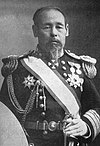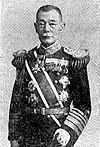Imperial Japanese Navy General Staff

The Imperial Japanese Navy General Staff (軍令部, Gunreibu) was the highest organ within the Imperial Japanese Navy. In charge of planning and operations, it was headed by an Admiral headquartered in Tokyo.
History
[edit]Created in 1893, the Navy General Staff took over operational (as opposed to administrative) authority over the Imperial Japanese Navy from the Navy Ministry. It was responsible for the planning and execution of national defense strategy. Through the Imperial General Headquarters it reported directly to the Emperor, not to the Prime Minister, National Diet or even the Navy Ministry. It was always headed by an admiral on active duty, and was based in Tokyo.
"The ministry was responsible for the naval budget, ship construction, weapons procurement, personnel, relations with the Diet and the cabinet and broad matters of naval policy. The General Staff directed the operations of the fleet and the preparation of war plans".[1]
After the Washington Naval Conference of 1921–22, where Japan agreed to keep the size of its fleet smaller than that of the United Kingdom and the United States, the Imperial Japanese Navy became divided into the mutually hostile Fleet Faction and Treaty Faction political cliques. The Navy Ministry tended to be pro-Treaty Faction and was anxious to maintain the Anglo-Japanese Alliance. However the Navy General Staff came to be dominated by the Fleet faction, and gradually gained ascendancy in the 1930s with increasing Japanese militarism. The Navy General Staff pushed through the attack on Pearl Harbor against the wishes of the more diplomatic Navy Ministry.
After 1937, both the Navy Minister and the Chief of the Navy General Staff were members of the Imperial General Headquarters.
With the defeat of the Empire of Japan in World War II, the Navy General Staff was abolished together with the Imperial Japanese Navy by the American occupation authorities in November 1945 and was not revived by the post-war Constitution of Japan.
Organization
[edit]The General Staff was organized as follows:
- 1st Department: Operations Bureau
- 1st Section: Operations
- 2nd Section: Training
- 2nd Department: Weapons and Mobilization Bureau
- 3rd Section: Weapons
- 4th Section: Mobilization
- 3rd Department: Intelligence Bureau
- 5th Section: Intelligence for America
- 6th Section: Intelligence for China
- 7th Section: Intelligence for Soviet Union
- 8th Section: Intelligence for UK and Europe
- 4th Department: Communications Bureau
- 9th Section: Communications
- 10th Section: Cryptography
Chiefs of the General Staff
[edit]| No. | Portrait | Chief of the General Staff | Took office | Left office | Time in office |
|---|---|---|---|---|---|
| 1 | Rear Admiral Itō Toshiyoshi 伊藤雋吉 (1840–1921) | 8 March 1889 | 17 May 1889 | 70 days | |
| 2 | Rear Admiral Arichi Shinanojō 有地品之允 (1843–1919) | 17 May 1889 | 17 June 1891 | 2 years, 31 days | |
| 3 | Rear Admiral Baron Inoue Yoshika 井上良馨 (1845–1929) | 17 June 1891 | 12 December 1892 | 1 year, 178 days | |
| 4 | Vice Admiral Viscount Nakamuta Kuranosuke 中牟田倉之助 (1837–1916) | 12 December 1892[a] | 18 July 1894[b] | 1 year, 218 days | |
| 5 | Vice Admiral[c] Viscount Kabayama Sukenori 樺山資紀 (1837–1922) | 18 July 1894 | 11 May 1895[d] | 297 days | |
| 6 | Vice Admiral[f] Itō Sukeyuki[e] 伊藤雋吉 (1843–1914) | 11 May 1895 | 20 December 1905 | 10 years, 223 days | |
| 7 | Admiral Tōgō Heihachirō[g] 東郷平八郎 (1848–1934) | 20 December 1905 | 1 December 1909 | 3 years, 346 days | |
| 8 | Vice Admiral[h] Baron Ijūin Gorō 伊集院五郎 (1848–1934) | 1 December 1909 | 22 April 1914 | 4 years, 142 days | |
| 9 | Vice Admiral[j] Shimamura Hayao[i] 島村速雄 (1858–1923) | 22 April 1914 | 1 December 1920 | 6 years, 223 days | |
| 10 | Admiral Yamashita Gentarō 山下源太郎 (1863–1931) | 1 December 1920 | 15 April 1925 | 4 years, 135 days | |
| 11 | Admiral Kantarō Suzuki 鈴木貫太郎 (1868–1948) | 15 April 1925 | 22 January 1929[k] | 3 years, 282 days | |
| 12 | Admiral Katō Hiroharu 加藤寛治 (1870–1939) | 22 January 1929 | 11 June 1930[l] | 1 year, 140 days | |
| 13 | Vice Admiral Taniguchi Naomi 谷口尚真 (1870–1941) | 11 June 1930 | 2 February 1932[m] | 1 year, 236 days | |
| 14 | Admiral[n] Prince Fushimi Hiroyasu 伏見宮博恭王 (1875–1946) | 2 February 1932 | 9 April 1941 | 9 years, 66 days | |
| 15 | Admiral[o] Nagano Osami 永野修身 (1880–1947) | 9 April 1941 | 21 February 1944[p] | 2 years, 318 days | |
| 16 | Admiral Shimada Shigetarō 嶋田繁太郎 (1883–1976) | 21 February 1944[q] | 2 August 1944[r] | 163 days | |
| 17 | Admiral Oikawa Koshirō 及川古志郎 (1883–1958) | 2 August 1944 | 29 May 1945[s] | 300 days | |
| 18 | Admiral Toyoda Soemu 豊田副武 (1885–1957) | 29 May 1945 | 15 October 1945 | 139 days |
See also
[edit]Notes
[edit]- ^ Concurrently Headmaster of the Naval War College until 20 May 1893.
- ^ Re-assigned to Privy Council over objections to escalating hostilities with China that led to the First Sino-Japanese War.
- ^ Promoted to Admiral on 5 May 1895.
- ^ Resigned to accept appointment as first Governor-General of Taiwan.
- ^ Created Viscount on 5 August 1898.
- ^ Promoted to Admiral on 28 September 1898.
- ^ Created Count on 21 September 1907.
- ^ Promoted to Admiral on 1 December 1910.
- ^ Created Baron on 14 July 1916.
- ^ Promoted to Admiral on 28 August 1915.
- ^ Resigned to become Grand Chamberlain.
- ^ Resigned rather than attend a state dinner in honor of US Ambassador William Richards Castle Jr.
- ^ Forced to resign due to tepid support for the Japanese invasion of Manchuria.
- ^ Promoted to Marshal Admiral on 27 May 1932.
- ^ Promoted to Marshal Admiral on 21 June 1943.
- ^ Forced to resign following Operation Hailstone.
- ^ Concurrently Minister of the Navy until 17 July 1944.
- ^ Forced to resign after the downfall of the Tōjō Cabinet following the loss of Saipan.
- ^ Resigned in protest of the Emperor's refusal to consider peace proposals.
References
[edit]- ^ Spector
Bibliography
[edit]- Asada, Sadao (2006). From Mahan to Pearl Harbor: The Imperial Japanese Navy and the United States. US Naval Institute Press. ISBN 1-55750-042-8.
- Schencking, J. Charles (2005). Making Waves: Politics, Propaganda, And The Emergence Of The Imperial Japanese Navy, 1868-1922. Stanford University Press. ISBN 0-8047-4977-9.
- Spector, Ronald (1985). Eagle Against the Sun. New York: Vintage Books. ISBN 0-394-74101-3.
External links
[edit]- "Foreign Office Files for Japan and the Far East". Adam Matthew Publications. Accessed 2 March 2005.






![Itō Sukeyuki[e] 伊藤雋吉](http://upload.wikimedia.org/wikipedia/commons/thumb/1/18/Itoh_Sukeyuki.jpg/100px-Itoh_Sukeyuki.jpg)
![Tōgō Heihachirō[g] 東郷平八郎](http://upload.wikimedia.org/wikipedia/commons/thumb/0/02/T%C5%8Dg%C5%8D_Heihachir%C5%8D.jpg/100px-T%C5%8Dg%C5%8D_Heihachir%C5%8D.jpg)

![Shimamura Hayao[i] 島村速雄](http://upload.wikimedia.org/wikipedia/commons/thumb/b/be/Shimamura_Hayao.jpg/100px-Shimamura_Hayao.jpg)



![Taniguchi Naomi [ja] 谷口尚真](http://upload.wikimedia.org/wikipedia/commons/thumb/0/0f/Naomi_Taniguchi.jpg/100px-Naomi_Taniguchi.jpg)





